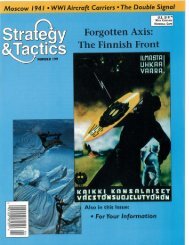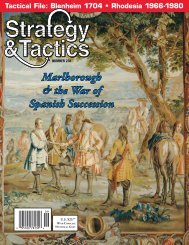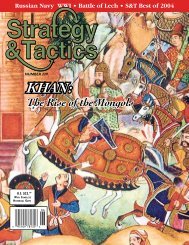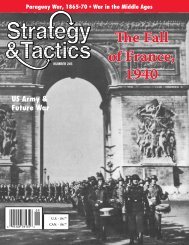the franco-prussian war - Strategy & Tactics
the franco-prussian war - Strategy & Tactics
the franco-prussian war - Strategy & Tactics
Create successful ePaper yourself
Turn your PDF publications into a flip-book with our unique Google optimized e-Paper software.
sighting or no sighting. The SC was eventuallyswitched on on o<strong>the</strong>r ships after 2325, as SANFRANCISCO made a sighting with hers. This,coupled with <strong>the</strong> facts that "Gotowascompletely surprised" - Morrison's wordsshows that radar was important at CapeEsperance; Goto's last words to his staff -"Bakasaro! Bakasaro!" ("stupid bastards,stupid bastards") deserves to be one of <strong>the</strong>great naval quotations. The rest of yourappreciation of Cape Esperance is , of course,quite correct.B. DESCRIPTIVE MODULES1. I consider <strong>the</strong> Japanese BB's successful in<strong>the</strong> bombardment role, as <strong>the</strong>y only really hadone good night (<strong>the</strong> 14th of October). Yet <strong>the</strong>CHOKAI and KlNGUSAand <strong>the</strong>n MYOKO andMAYA, which bombarded on subsequentnights, threw almost as much explosive as <strong>the</strong>two battleships (1,552 &inch and 500+ 5-inchshells). As for all Japanese destroyer squadronshaving leaders, I would hate to commitmyself to such a categorical statement,especially after Guadalcanal. But if not all had<strong>the</strong>m, <strong>the</strong>n almost all. Your example ofTROMP as a good destroyer leader issomewhat unusual, as TROMP could barelymake 32 knots, thus making it difficult for it tokeep up with destroyers in a calm sea. It wasdesigned not to lead destroyers, but to sinkdestroyers, especially <strong>the</strong> FUBUKI class oneswhose appearance caused TROMP'S construction.The first time TROMP ran up againstone of <strong>the</strong>se destroyers, however, it wastorpedoed and had to limp off for repairs, thusending its career as a destroyer-destroyerbefore it started. What made <strong>the</strong> JapaneseCL's so good as destroyer leaders was (amongo<strong>the</strong>r things) <strong>the</strong>ir high speed, which <strong>the</strong>ycould sustain. I doubt that DUNCAN orFAHRENHOLT hit anything at Cape Esperance.They were too busy saving <strong>the</strong>ir ownskins and claimed FUBUKI as a cruiser, sonaturally <strong>the</strong>ir ideas would be a wee bitinflated. As for <strong>the</strong> belt on Americanbattleships, you are correct, although I haveheard it said that <strong>the</strong> 12" belt was soconstructed to give <strong>the</strong> protection of 18". Inmy files, I have a notation that TENRYU,TATSUTA, and YUBARI were refitted withType 93 torpedoes. Nei<strong>the</strong>r, as you said,carried reloads.2. Naval OrdnanceOne thing I don't think most people havepicked up is that <strong>the</strong> Model 0 rounds carried by<strong>the</strong> BB's on 13 November (at least some of it)was air-fused, so that it would burst aboveground and perforate <strong>the</strong> airplanes in <strong>the</strong>irrevetments. A contact HE would probablyhave exploded. That AP does go through thinships is, of course, correct. It also happened toHOEL and/or JOHNSTON at Leyte, accordingto Theodore Roscoe. Your statement on <strong>the</strong>ammunition used on 13 November is interesting,but most of <strong>the</strong> American accounts(Morrison, and especially Coggins) make muchout of <strong>the</strong> Japanese using HE. It must beremembered that <strong>the</strong> BB's decks were piledwith hE shells which were deep-sixed as soonas <strong>the</strong> AKATZUKl's searchlight came on.As for your corrections to my table. I have seenseveral different charts of this sort, and mineis a syn<strong>the</strong>sis of many. So I would be hesitantto say who is right on anything. I was,however, ignorant of <strong>the</strong> difference betweenMark 9 and Mark 10 8-inchers. Live and learn.Your statement on torpedoes is also interestingand amplifies <strong>the</strong> data given on <strong>the</strong> text.The Mk 10's and Mk 14's were little differentthan <strong>the</strong> torpedoes used by all surface ships. Ihave read several contradictory statementsabout Japanese aircraft torpedoes.As for "Hit and Hard Hit, "contrary to <strong>war</strong>timepropaganda, I don't think SOUTH DAKOTAwas in that much danger. With WASHING-TON hitting KIRSHIMA, she had little to worryabout from that quarter, but if one of <strong>the</strong>cruisers or even destroyers had gotten a fewtorpedoes off at that halted, burning target. . .These are not <strong>the</strong> only errors in <strong>the</strong> article,some of <strong>the</strong>m due to typographical error andomission due to lack of space.In <strong>the</strong> text, on page 8, <strong>the</strong> Japanese whoproposed a "battleship solution" relied on astrategy of "attenuation," having come upwith <strong>the</strong> dubious formula that a fleet loses 10%of its effectiveness for every 1,000 milesadvanced from its bases. The Japanese alsohoped to whittle away American strength bysubmarine attacks, but as <strong>the</strong> Japanese wouldalso divide <strong>the</strong>ir fleet, <strong>the</strong> success of this planwas also dubious. So <strong>the</strong> use of airpower, bothland and ship based, became more attractive.The module "Hit and Hit Hard.. ." is itself atypo; its correct title should be "Hit and HardHit," a quotation from Kipling's The Destroyers.In this module, "BENTON" should be"BENSON" and in <strong>the</strong> chart at <strong>the</strong> end, 12"shells should read 16-12'' shells. Theuncaptioned photograph heading of <strong>the</strong> NavalOrdnance Module is <strong>the</strong> 16" guns of a Nagatoclass BB.O<strong>the</strong>r casualties to editing were <strong>the</strong> followingpieces of information, indexed to <strong>the</strong> "CA"article:"The Strategic Overview"-p. 6. While <strong>the</strong> baseat Pearl Harbor was established in <strong>the</strong> 1920's,much of <strong>the</strong> American Pacific Fleet remainedat San Diego and Seattle until 1940, but PearlHarbor was always envisioned as <strong>the</strong>ir<strong>war</strong>time base."Evolution of <strong>the</strong> Naval Battle" - p. 17. Thefirst and last paragraph of <strong>the</strong> comments on<strong>the</strong> Battle of Cape St. George are editedversions of "The War Goes ON," a module on<strong>the</strong> Naval fighting after 1943 that we couldnot fit in."Hit and Hard Hit. . . " - p. 12 <strong>the</strong> followingexamples were cut: The CL Sendai was sunkafter being hit by two torpedoes and six 6"shells. The destroyer TERUZUKI was sunk byone torpedo, while <strong>the</strong> destroyer FUBUKI tookfour 81' and 6" shells. The Helena, an AmericanCL, sank after being hti by three Long Lancesamidships and <strong>the</strong> destroyer Kearny survived a21" torpedo hit amidships.Main text, p. 19: One of <strong>the</strong> most obvious of<strong>the</strong> stereotyped "textbook" maneuvers usedby <strong>the</strong> Japanese was <strong>the</strong> "Neptune's Trident"formation of three parallel columns. Althoughit had proved unsuccessful at Cape Esperance,it was retained and proved disastrous for <strong>the</strong>Japanese at <strong>the</strong> 2nd Battle of Guadalcanal and<strong>the</strong> Battle of Empress Augusta Bay, and it wasone of <strong>the</strong> causes for <strong>the</strong> Japanese defeats in<strong>the</strong>se two battles.In reading <strong>the</strong> letters by <strong>the</strong> learned gentlemenwho wish to add fur<strong>the</strong>r detail to <strong>the</strong>information appearing in <strong>the</strong> '%A" article, Irealized that <strong>the</strong>se were people who were wellversed in <strong>the</strong> subjects I covered and thus couldoffer detail from <strong>the</strong>ir own knowledge. Thismaterial is welcome - that is why we arepublishing it in MOVES, but I should like topoint out that <strong>the</strong> "CA" article, like <strong>the</strong> game,was not aimed at <strong>the</strong> naval enthusiast. It wasaimed at <strong>the</strong> average reader of <strong>Strategy</strong> 8<strong>Tactics</strong> who, as <strong>the</strong> Feedback and personalcontact shows us, has no great or deepprevious knowledge of naval matters, especiallyin <strong>the</strong> myriad technical details that makemodern fleets specialists ra<strong>the</strong>r than seamen.So I wrote an article stressing <strong>the</strong> maincurrents, instead of details. I worked <strong>the</strong> detailsand examples in as well as <strong>the</strong>y could beintegrated, but it remains that "CA" is not anit-picking article. I can pick nits with <strong>the</strong> bestof <strong>the</strong>m, as some may say this articleillustrates. Yet this is not to denigrate thosewith a deep interest in naval <strong>war</strong>fare, forwhose benefit <strong>the</strong> preceding comments haveappeared, along with fulfilling our dutyto<strong>war</strong>ds our readers for complete, correctmaterial!Designer% Notes (continued from page 3)least one game-in-development each issue.This one will have have a lot of uniquefeatures. Not <strong>the</strong> least of which is <strong>the</strong> generalignorance outside of Manchuria about justwhat is going on over <strong>the</strong>re. It wasn't toodifficult doing <strong>the</strong> terrain analysis of <strong>the</strong> area(which results in <strong>the</strong> game map). Physically,Manchuria is not well connected to <strong>the</strong> rest ofChina. Most observers and "experts" agreethat Manchuria would be <strong>the</strong> major, anddecisive, battleground in a Russo-Chinese <strong>war</strong>in <strong>the</strong> 1970's. Manchuria possesses only about8% of China's population but, more importantly,nearly a third of her industry. Inaddition, Manchuria contains many irreplaceableraw materials. China is <strong>the</strong>refore forced todefend Manchuria. It is commonly felt that <strong>the</strong>Russians would quickly "blitz" <strong>the</strong> Chineseright out of Manchuria. This is one possibility.There are many o<strong>the</strong>rs. This will be one gamewhere you will be given numerous scenarios.And <strong>the</strong>n be free to chose <strong>the</strong> one that seemsmost likely. It will be largely a matter of taste.Or what YOU think will happen.For <strong>the</strong> Russians it is not exactly a "cakewalk."They can converge from three sides. Butwherever <strong>the</strong>y come from <strong>the</strong>y will have tofirst deal with formidable physical obstacles. If<strong>the</strong>y come from Outer Mongolia <strong>the</strong>y will haveto cross <strong>the</strong> Greater Khingan Mountains. Usingtactical nuclear weapons <strong>the</strong>y could blast <strong>the</strong>irway to<strong>war</strong>ds Peking and thus cut off all ofManchuria. But this would gain <strong>the</strong>m little in<strong>the</strong> short run as <strong>the</strong> numerous industrializedareas of Manchuria (along with <strong>the</strong>ir militia andregular armies) would have to be reduced. Ablitz across <strong>the</strong> Manchurian plain from <strong>the</strong> eastwould take <strong>the</strong>m across <strong>the</strong> Lesser KhinganMountains (which are "lesser" in name onlyfrom a military point of view). And, just tocomplete <strong>the</strong> ring, along <strong>the</strong> Yalu (<strong>the</strong> NorthKorean border) are <strong>the</strong> Chang Pai Mountains.Real messy stuff. The scale of <strong>the</strong> Map is 55kilometers to a hex. The map covers an area of1.3 million square miles. In o<strong>the</strong>r words, about<strong>the</strong> same area as <strong>the</strong> United States east of <strong>the</strong>Mississippi. Not a very tactical game. Unitsrepresent corps or "armies" of two to fourdivisions. Also represented are Soviet airarmies and amphibious forces (Marines and(continued on page 13)







